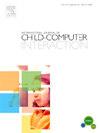Children's information search with social robots: A focus on Children's question-asking behavior
Q1 Social Sciences
International Journal of Child-Computer Interaction
Pub Date : 2025-06-13
DOI:10.1016/j.ijcci.2025.100751
引用次数: 0
Abstract
As programmable virtual agents/robots are becoming increasingly common, it is essential to examine children's interactions with these technological tools. In this study, we examined how 35 5 to 9-year-old children interact with a social robot (NAO) during a Question Elicitation Task. Following receiving informed consent and demographics information from parents, we tested children individually in their schools. We invited children to ask questions to the robot about animals and objects. The robot provided scripted responses to children's questions across informative and noninformative answer conditions, presented in a fixed order. Children first received informative answers, and then non-informative answers. We simulated smooth conversations with the robot using a Wizard of Oz teleoperation interface using a Python GUI. This interface allowed us to respond to children's questions via a scripted response database generated by GPT-4 that we reviewed and edited for accuracy. If children asked questions beyond the database, this interface also allowed us to regenerate responses from GPT-4 online. Findings showed that children perceived robots as a friendly technological device rather than a living entity and asked the robot information-seeking questions about animals and objects. About 25–30 % of children's information-seeking questions were explanation-seeking. They asked fewer questions when they received non-informative answers than informative answers but this effect disappeared when frequency of questions were adjusted for the length of talk. Children mostly asked about label, function/behavior and physical properties of the items. We discuss these findings within the context of children's learning from social robots.

基于社交机器人的儿童信息搜索:对儿童提问行为的关注
随着可编程虚拟代理/机器人变得越来越普遍,检查儿童与这些技术工具的互动是必不可少的。在这项研究中,我们研究了35名5至9岁的儿童在问题引出任务中如何与社交机器人(NAO)互动。在获得家长的知情同意和人口统计信息后,我们在他们的学校对儿童进行了单独测试。我们邀请孩子们向机器人提问关于动物和物体的问题。机器人对孩子们的问题按照固定的顺序,在有信息和没有信息的情况下提供脚本式的回答。孩子们首先得到了信息性的答案,然后是非信息性的答案。我们使用一个Python GUI的Wizard of Oz远程操作界面来模拟与机器人的流畅对话。这个界面允许我们通过GPT-4生成的脚本回答数据库来回答孩子们的问题,我们对这些数据库进行了审查和编辑,以确保准确性。如果孩子们问的问题超出了数据库,这个界面还允许我们重新生成GPT-4的在线回答。研究结果表明,儿童将机器人视为一种友好的技术设备,而不是一个活生生的实体,并向机器人询问有关动物和物体的信息。约25 - 30%的儿童信息寻求问题为解释寻求问题。当他们得到非信息性答案时,他们问的问题比得到信息性答案时少,但当问题的频率根据谈话的长度进行调整时,这种影响就消失了。孩子们主要询问物品的标签、功能/行为和物理性质。我们在儿童向社交机器人学习的背景下讨论这些发现。
本文章由计算机程序翻译,如有差异,请以英文原文为准。
求助全文
约1分钟内获得全文
求助全文
来源期刊

International Journal of Child-Computer Interaction
Social Sciences-Education
CiteScore
7.20
自引率
0.00%
发文量
73
 求助内容:
求助内容: 应助结果提醒方式:
应助结果提醒方式:


